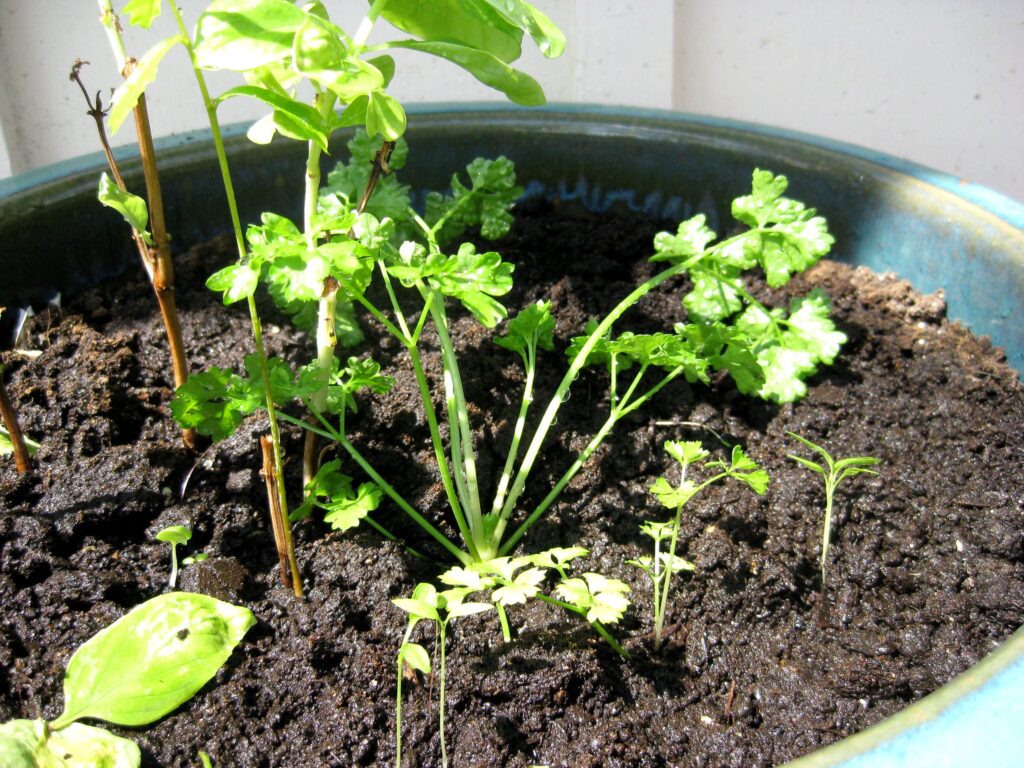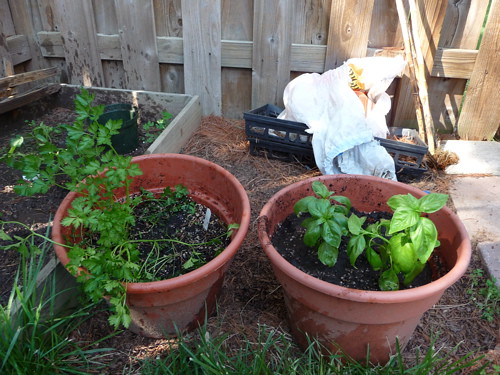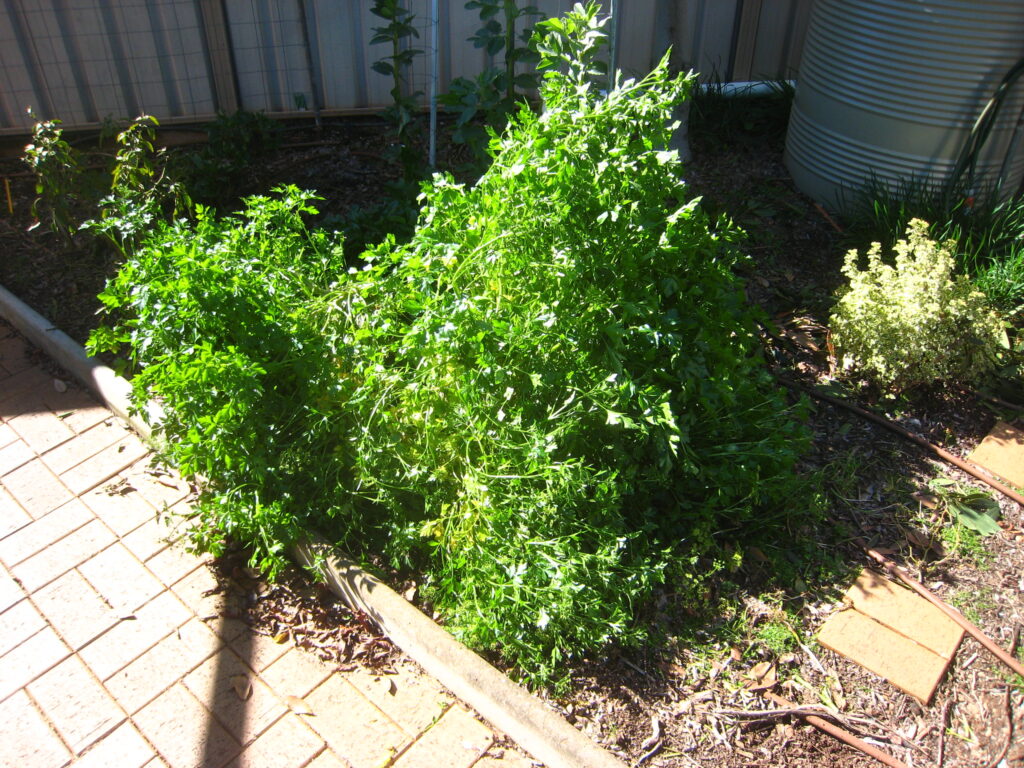Parsley is a versatile and nutritious herb that can be used in a variety of dishes, from salads and soups to sauces and marinades. However, growing parsley can be a bit tricky, especially for those who are new to gardening. So, it is critical as with all gardening endeavors that you plan your garden effectively.
Whether you have a large garden, a balcony, or just a windowsill, we’ll provide you with tips and tricks to help you cultivate healthy and flavorful parsley plants. Join us as we explore the ins and outs of parsley cultivation, from soil preparation to harvesting and preservation, and discover how easy it can be to grow this delicious herb at home!
Parsley Soil Preparation
Before planting parsley, it’s important to prepare the soil to provide the best growing conditions for the plant. The ideal soil pH level for parsley is between 6.0 and 7.0, so you may need to adjust the pH level if it’s too acidic or alkaline. You can test your soil’s pH level using a soil test kit, which can be purchased from most gardening suppliers on Garden Savvy.

To improve the soil’s fertility and texture, you can add organic matter such as compost, well-rotted manure, or leaf mold. Organic matter can help the soil retain moisture, improve its structure, and provide nutrients for the parsley plant.
When planting parsley, it’s also important to ensure that the soil has good drainage. Parsley prefers soil that’s moist but not waterlogged. To improve drainage, you can add perlite, vermiculite, or coarse sand to the soil.
To prepare the soil for planting, first, remove any weeds or rocks from the planting area. Next, use a garden fork or tiller to loosen the soil to a depth of about 8-10 inches. Add any necessary soil amendments, such as organic matter or pH adjusters, and mix them thoroughly into the soil. Finally, rake the soil surface smooth and level before planting the parsley seeds or seedlings.
By taking the time to properly prepare the soil for parsley, you can provide your plants with the best growing conditions and ensure a healthy and productive crop.
How to Plant Parsley
Planting parsley can be done either by sowing seeds directly into the soil or transplanting seedlings. Here are some tips on how to plant parsley successfully.
- Planting Parsley Seeds: First, soak the parsley seeds in warm water overnight before planting. This will help to speed up germination. Sow the seeds about 1/4 inch deep and 6-8 inches apart, in rows that are spaced about 12 inches apart. Cover the seeds with soil and gently press down to ensure good contact with the soil. Water the seeds thoroughly but gently, taking care not to displace them. Keep the soil moist but not waterlogged until the seeds germinate, which typically takes around 2-3 weeks.
- Planting Parsley Seedlings: Transplant the seedlings into the garden once they have grown to a height of around 3-4 inches. Dig a hole slightly larger than the root ball of the seedling and place it in the hole so that the top of the root ball is level with the soil surface. Space the seedlings 6-8 inches apart in rows that are 12 inches apart. Water the seedlings thoroughly after transplanting.
- Spacing Requirements and Depth: Parsley plants should be spaced 6-8 inches apart in rows that are 12 inches apart. Seeds should be planted about 1/4 inch deep in the soil, and covered with soil to ensure good contact.
- Watering and Mulching: Parsley requires regular watering, especially during dry periods. Water deeply once or twice a week, taking care not to overwater or let the soil become waterlogged. Mulching around the plants can help to retain moisture in the soil and suppress weeds. Use organic mulches such as straw, shredded leaves, or grass clippings, and apply a layer about 2-3 inches thick around the plants.

Parsley Light and Water Requirements
Light and water are essential factors for the growth and productivity of parsley. Here’s what you need to know about providing the right amount of light and water to your parsley plants.
Light Requirements: Parsley plants prefer to grow in partial shade to full sun. They require at least 4-6 hours of direct sunlight each day to thrive. However, in hot climates, parsley may benefit from some afternoon shade to protect it from intense heat.
Water Requirements: Parsley requires consistently moist soil to grow well. Water the plants deeply at least once a week, and more often during hot or dry weather. Avoid overwatering the plants, as this can cause root rot and other diseases. Allow the top inch of soil to dry out slightly between waterings.
Signs of Too Much Water: If parsley is getting too much water, the leaves may turn yellow or brown and start to wilt. The soil may also appear waterlogged or have a foul odor.
Signs of Too Little Water: If parsley is not getting enough water, the leaves may start to curl and turn brown or yellow. The soil may also be dry to the touch and the plant may appear stunted.
In addition to watering, mulching around the parsley plants can help to retain moisture in the soil and reduce the frequency of watering.
By providing the right amount of light and water, you can ensure that your parsley plants stay healthy and productive throughout the growing season.

How to Fertilize Parsley
Fertilizing parsley can help to provide the plant with the necessary nutrients to grow healthy and productive. Here’s what you need to know about fertilizing parsley:
- Fertilizer Types: There are many different types of fertilizers that can be used for parsley, but a balanced fertilizer with equal amounts of nitrogen, phosphorus, and potassium (NPK) is ideal. Organic fertilizers such as compost, well-rotted manure, or fish emulsion can also be used to provide the plant with nutrients.
- When to Fertilize: Parsley should be fertilized every 4-6 weeks during the growing season, which is typically from spring to fall. Avoid fertilizing during the winter months or when the plant is dormant.
- How to Apply Fertilizer: Fertilizer should be applied evenly around the base of the plant, taking care not to get any on the leaves. Follow the manufacturer’s instructions for the amount of fertilizer to use, or apply a handful of compost or well-rotted manure per plant.
- Other Fertilizing Tips: Avoid over-fertilizing, as this can lead to excess growth and reduce the flavor of the parsley. Water the plants thoroughly after applying fertilizer to help the nutrients penetrate the soil. Mulching around the plants can help to retain moisture and prevent nutrient leaching.
- Signs of Nutrient Deficiency: If parsley plants are not getting enough nutrients, they may show signs of yellowing leaves, stunted growth, and reduced flavor.
In addition to fertilizing, keeping the parsley plants healthy and vigorous requires regular pruning to encourage new growth and remove any dead or damaged leaves. Harvesting the parsley regularly also helps to keep the plant healthy and encourages new growth.

Parsley Pests and Diseases
Like all plants, parsley is vulnerable to a variety of pests and diseases. Here are some of the most common pests and diseases that can affect parsley plants, and how to prevent and treat them.
- Aphids: Aphids are small, soft-bodied insects that feed on the sap of plants, causing stunted growth and yellowing leaves. They can be controlled by spraying the plants with a mixture of water and dish soap, or by releasing ladybugs, which are natural predators of aphids.
- Spider Mites: Spider mites are tiny pests that feed on the underside of parsley leaves, causing yellowing and a fine webbing to appear. They can be controlled by spraying the plants with a mixture of water and neem oil or insecticidal soap.
- Whiteflies: Whiteflies are small, white insects that feed on the undersides of leaves, causing yellowing and stunted growth. They can be controlled by spraying the plants with a mixture of water and insecticidal soap or by releasing natural predators like lacewings or ladybugs.
- Leaf Spot: Leaf spot is a fungal disease that causes circular brown spots to appear on the leaves of parsley plants. It can be prevented by planting parsley in well-draining soil and avoiding overhead watering, as the fungal spores can spread through water droplets.
- Root Rot: Root rot is a fungal disease that causes the roots of the parsley plant to rot, leading to wilting and death. It can be prevented by planting parsley in well-draining soil and avoiding overwatering.
- Downy Mildew: Downy mildew is a fungal disease that causes yellowing and wilting of the parsley leaves. It can be prevented by planting parsley in a location with good air circulation and avoiding overhead watering.
- Carrot Rust Fly: Carrot rust fly is a pest that lays its eggs near the roots of parsley plants, causing the roots to become brown and rotten. It can be prevented by covering the plants with row covers or netting, or by planting the parsley near companion plants like garlic, which repel the flies.
In addition to these pests and diseases, parsley can also be affected by other pests such as slugs, snails, and cutworms. To prevent and treat these pests, use appropriate methods such as handpicking or applying diatomaceous earth. Regularly inspecting the parsley plants for signs of pests and diseases, and promptly treating any issues, can help to keep the plants healthy and productive.

How to Harvest Parsley
Harvesting parsley at the right time and storing it properly can help to maintain its flavor and nutrition. Here’s what you need to know about harvesting and storing parsley:
- When to Harvest: Parsley leaves can be harvested as soon as they are large enough to use, which is typically around 70-90 days after planting. Harvest the outer leaves first, leaving the center of the plant to continue growing. Avoid harvesting more than one-third of the plant at a time.
- How to Harvest: To harvest parsley, use a pair of sharp scissors or pruning shears to snip off the leaves or stems. Cut the stems at the base of the plant, taking care not to damage the other stems or leaves. Harvest in the morning, when the parsley is at its freshest.
- Storage Tips: Fresh parsley can be stored in the refrigerator for up to a week. Wash the leaves in cold water, pat them dry with a paper towel, and wrap them in a damp paper towel before placing them in a plastic bag. Parsley can also be frozen for later use. Wash and chop the leaves, and spread them out on a baking sheet to freeze. Once frozen, transfer them to a freezer-safe container or bag and store them in the freezer for up to six months. Dried parsley can be stored in an airtight container in a cool, dry place for up to a year. To dry parsley, hang the stems upside down in a warm, dry place until the leaves are dry and brittle, then remove the leaves from the stems and store them in an airtight container.
By harvesting parsley at the right time and storing it properly, you can enjoy the flavor and nutrition of this versatile herb year-round.

Parsley Cooking Ideas
Parsley is a versatile herb that can add flavor and nutrition to a variety of dishes. Here are some creative and delicious recipes that feature parsley as a key ingredient:
- Tabouli Salad: This Middle Eastern salad is made with bulgur wheat, parsley, tomatoes, cucumbers, and a lemon and olive oil dressing. It’s a refreshing and healthy dish that’s perfect for a summer picnic or BBQ.
- Chimichurri Sauce: This Argentinian sauce is made with parsley, garlic, red wine vinegar, and olive oil. It’s a delicious accompaniment to grilled meats or roasted vegetables, and can also be used as a marinade.
- Italian Gremolata: This classic Italian condiment is made with parsley, garlic, and lemon zest. It’s a great topping for grilled fish or chicken, or can be used as a flavor enhancer for soups and stews.
- Parsley Pesto: This twist on classic basil pesto is made with parsley, pine nuts, Parmesan cheese, and garlic. It’s a great topping for pasta or roasted vegetables, or can be used as a spread for sandwiches or bruschetta.
- Green Goddess Dressing: This creamy dressing is made with parsley, avocado, Greek yogurt, and lemon juice. It’s a healthy and delicious alternative to store-bought dressings, and can be used as a dip or dressing for salads and veggies.
- Parsley and Lemon Roasted Chicken: This simple yet flavorful dish is made by roasting a whole chicken with fresh parsley, lemon zest, and garlic. It’s a great option for a Sunday dinner or special occasion.
- Parsley and Feta Stuffed Peppers: This vegetarian dish is made by stuffing bell peppers with a mixture of cooked rice, feta cheese, and parsley. It’s a filling and nutritious option for lunch or dinner.
By incorporating parsley into these and other dishes, you can add flavor and nutrition to your meals and get more creative with your cooking.
Parsley Companion Plants
Companion planting is a gardening technique where different plants are grown together to promote growth and repel pests. Parsley is a great herb to pair with other plants, as it can benefit both the parsley plant and its companion plants. Here are some plants that parsley pairs well with.
- Tomatoes: Tomatoes and parsley make great companions, as parsley repels tomato hornworms and can also improve the flavor of tomatoes. Plant parsley near the base of the tomato plants to help repel pests.
- Chives: Chives and parsley make a great combination, as they both prefer similar growing conditions and can help to repel pests like aphids and Japanese beetles. Plant them together in a raised bed or container for a delicious and pest-free harvest.
- Basil: Basil and parsley are both popular herbs that can add flavor and nutrition to a variety of dishes. They also repel pests like mosquitoes and flies, making them great companions in the garden.
- Rosemary: Rosemary and parsley make great companions, as rosemary can help to repel pests like cabbage moths and improve the flavor of parsley. Plant them together in a sunny location with well-draining soil.
- Lettuce: Parsley and lettuce are both cool-season crops that prefer similar growing conditions. Plant them together in a raised bed or container for a nutritious and flavorful salad harvest.
By planting parsley with these and other compatible plants, you can create a diverse and thriving garden that promotes growth and repels pests. Experiment with different combinations to find the perfect pairings for your garden.
Growing Parsley Indoors
Growing parsley indoors is a great option for those who don’t have access to outdoor space or live in areas with limited growing seasons. Here are some tips for growing parsley indoors.
- Choosing the Right Container: Choose a container with good drainage and enough room for the parsley to grow. A 6-8 inch diameter pot is ideal for growing parsley indoors.
- Providing Adequate Light: Parsley requires at least 4-6 hours of direct sunlight each day to grow well. Place the container in a sunny window or use artificial grow lights to provide the necessary light.
- Watering: Parsley requires consistently moist soil to grow well. Water the plant deeply once a week, taking care not to overwater or let the soil become waterlogged.
- Fertilizing: Fertilize the parsley plant every 4-6 weeks with a balanced fertilizer to provide the necessary nutrients for growth. Follow the instructions on the fertilizer package for the amount to use.
- Pruning: Regularly pruning the parsley plant can help to promote new growth and keep the plant healthy. Pinch off the outer leaves regularly to encourage the plant to produce new growth.
- Harvesting: Harvest the parsley leaves as soon as they are large enough to use. Avoid harvesting more than one-third of the plant at a time, and leave the center of the plant to continue growing.
- Other Tips: To encourage good air circulation and prevent pests, avoid overcrowding the parsley plants in the container. Mulching around the plant can help to retain moisture in the soil and suppress weeds. Rotate the container regularly to ensure all parts of the plant receive adequate light.
By following these tips, you can successfully grow parsley indoors and enjoy the flavor and nutrition of this versatile herb year-round.
Preserving Parsley
Preserving parsley is a great way to enjoy its flavor and nutrition year-round. Here are some tips for drying or freezing parsley.
- Drying Parsley: Drying parsley is a simple and effective way to preserve its flavor and nutrition. Here’s how to do it: Wash the parsley leaves and pat them dry with a paper towel. Tie the stems together with string or a rubber band, and hang them upside down in a warm, dry place. Once the leaves are dry and brittle, remove them from the stems and store them in an airtight container in a cool, dry place.
- Freezing Parsley: Freezing parsley is another great option for preserving its flavor and nutrition. Here’s how to do it: Wash the parsley leaves and pat them dry with a paper towel. Chop the leaves finely and spread them out in a single layer on a baking sheet. Place the baking sheet in the freezer and freeze the parsley for several hours or until it’s frozen solid. Once frozen, transfer the parsley to a freezer-safe container or bag and store it in the freezer for up to six months.
- Other Tips for Preserving Parsley: To preserve the flavor and nutrition of the parsley, avoid drying or freezing it with other strongly scented foods. Use a dehydrator for drying parsley for more consistent results and to reduce the drying time. Label the containers or bags with the date and contents to keep track of the parsley’s freshness.
Growing Parsley Conclusion
In conclusion, growing parsley can be a rewarding experience for both novice and experienced gardeners alike.
By following the tips and techniques covered in this blog, such as soil preparation, planting, light and water requirements, fertilization, pest and disease prevention, harvesting and storage, companion planting, and preserving, you can successfully grow parsley in your garden or even indoors.
With its versatile flavor and nutrition, parsley can be used in a wide range of culinary dishes, from salads and sauces to soups and stews. So go ahead and give parsley a try – with a little bit of care and attention, you can enjoy the delicious flavor and benefits of this herb all year round.

Contact Author
 info@gardensavvy.com
info@gardensavvy.com Recent Posts
- Smart Gardening: How Technology Is Revolutionizing Horticulture
- Understanding Gardening Zones: What You Need to Know
- The Right Tools For Your Gardening And Landscaping Needs
- Maximizing Your Harvest: Square Foot Gardening Chart for Beginners
- Holiday Garden Scents: Plants for Natural Aromatherapy in Your Home









